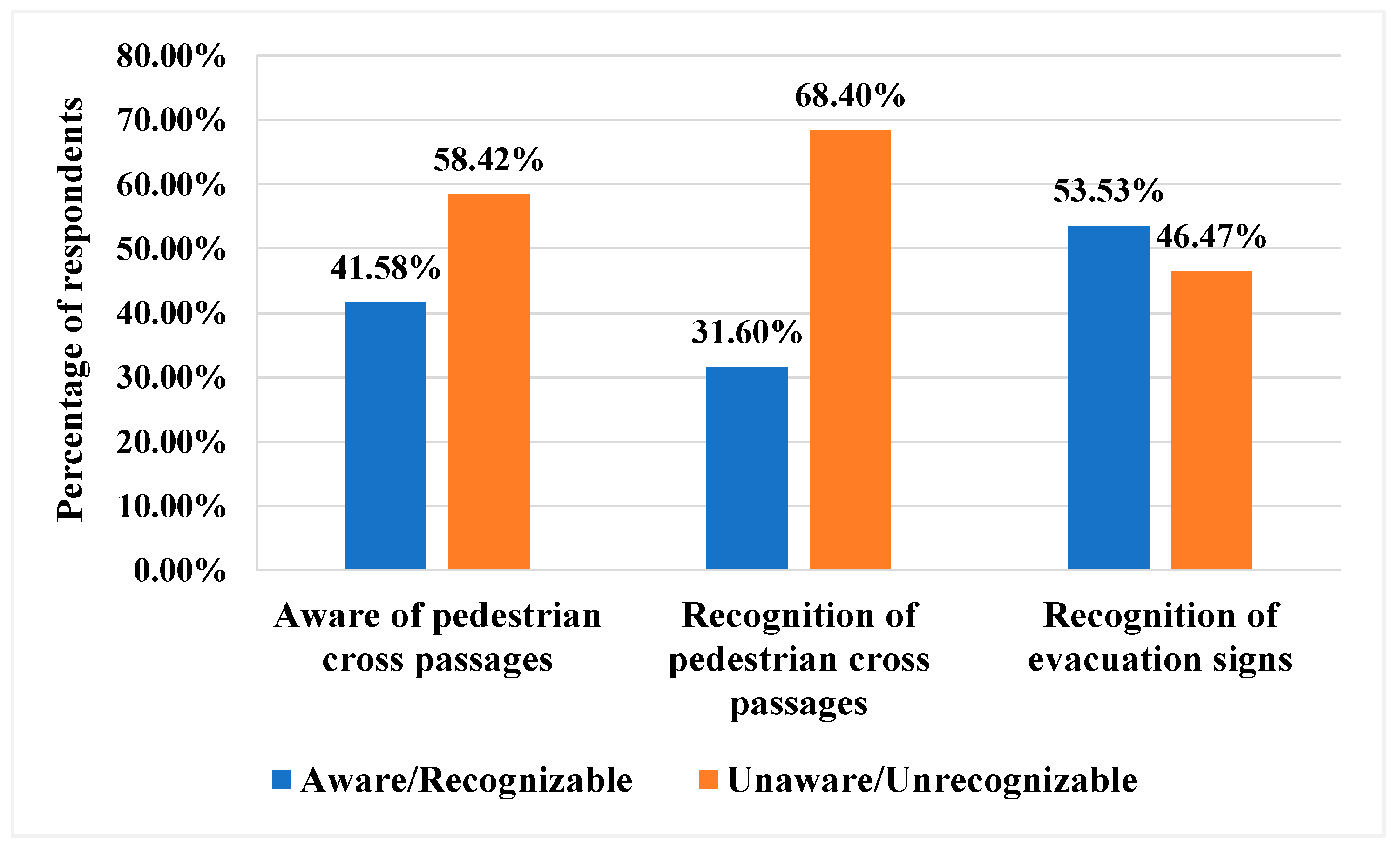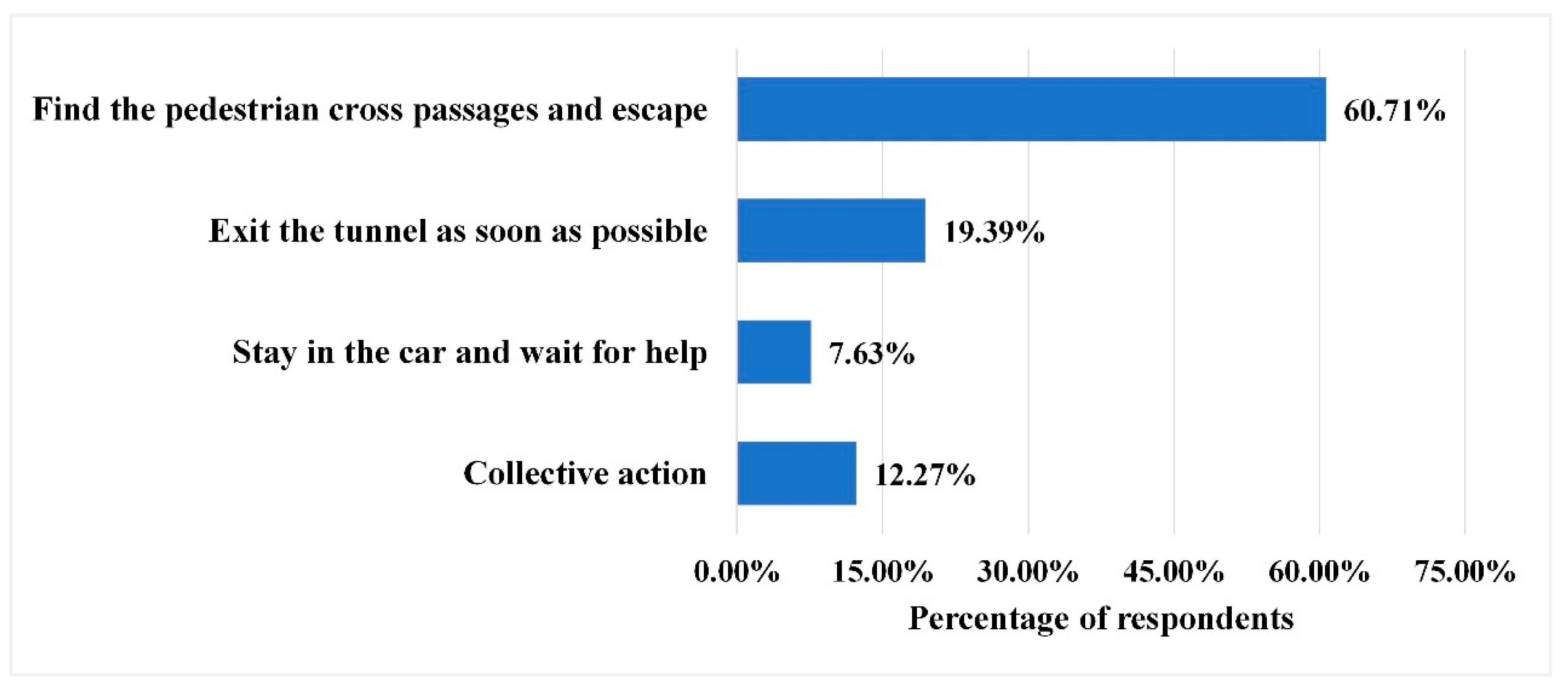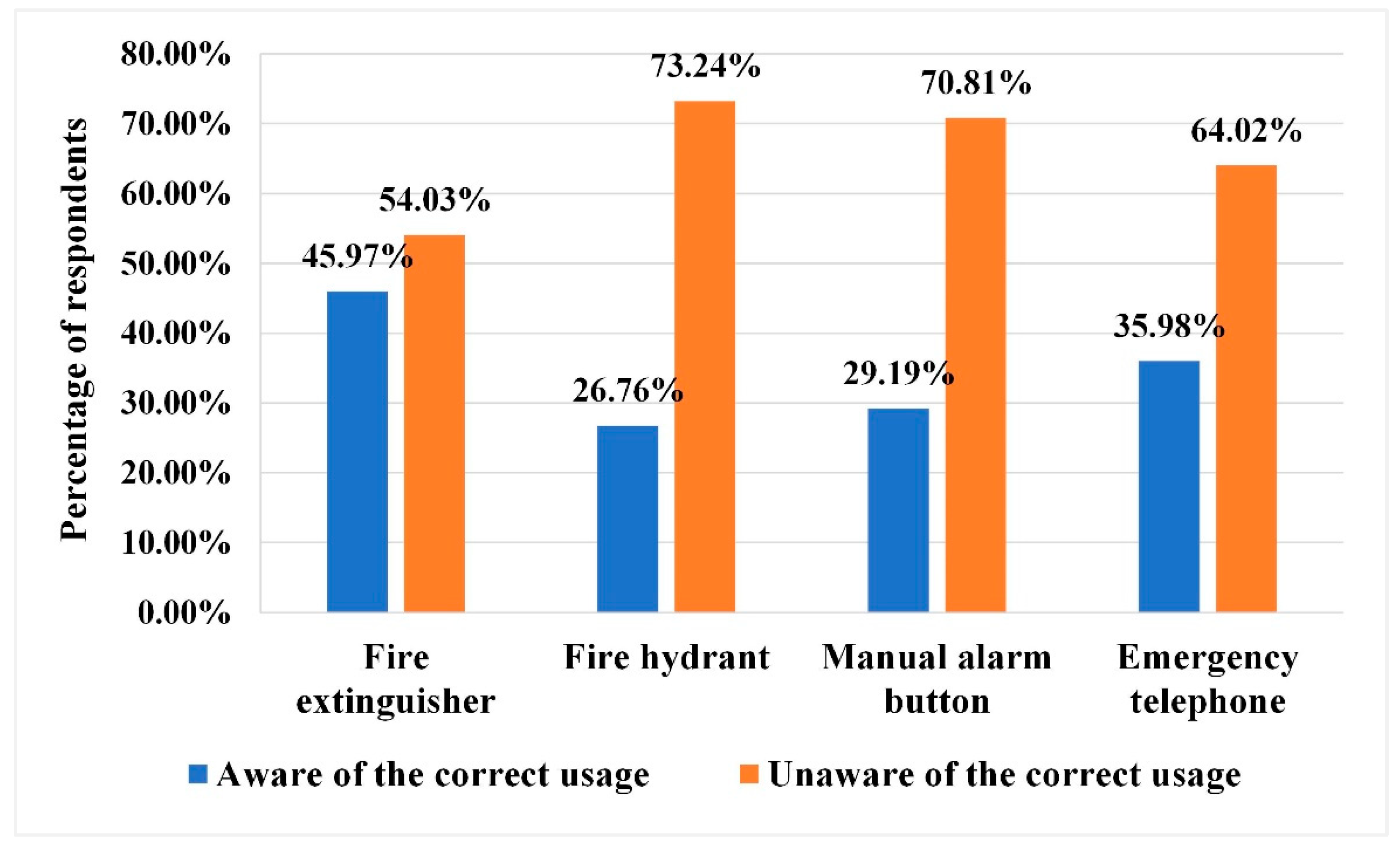3.2. Cognition of Escape Methods in Expressway Tunnels
In this study, an analysis of 1573 valid questionnaires was used to determine tunnel users’ understanding of expressway tunnel escape methods. There are pedestrian cross passages between adjacent tunnels designed for evacuation. Expressway tunnels of more than 500 m have pedestrian cross passages at intervals of no less than 250 m. As shown in
Figure 1, only 41.58% of people were aware of the pedestrian cross passages in expressway tunnels, and 58.42% lacked this awareness. Furthermore, only 31.60% of people were able to recognize the pedestrian cross passages in expressway tunnels, and 68.40% of them were unable. The results show that only a small proportion of people have knowledge of the escape facilities in expressway tunnels, and even fewer can use them correctly. Some of the respondents were aware of pedestrian cross passages, but unable to recognize them. They may have acquired knowledge of pedestrian cross passages through fire prevention lectures, news reports, and similar sources, but lacked a clear understanding of their locations, function, and use.
On both sides of a tunnel’s walls, pedestrian cross passages at the entrances and exits should be installed with appropriate evacuation signs to guide the direction of escape in case of fire. The analysis results of the survey data (see
Figure 1) revealed that only 53.53% of people were able to recognize evacuation signs in expressway tunnels, leaving 46.47% unable to do so. Clearly, almost half of the respondents are not familiar with crucial evacuation signs, which would impact their evacuation route selection and efficiency in tunnel fires. Promoting awareness of proper escape methods and improving fire safety literacy among people is crucial.
Through analyzing previous tunnel fire cases, tunnel users have tended to escape in a panic, leading to inappropriate choices of escape routes. This study explores the ability of people to choose the correct evacuation route in the middle section of an extra-long tunnel fire. As shown in
Figure 2, 12.27% of people believe that the correct evacuation route involves collective action and escape where there are many people. Additionally, 7.63% would choose to stay in the car and wait for help, while 19.39% would choose to quickly escape towards the entrances or exits of the tunnel and exit the tunnel as soon as possible. Moreover, 60.71% of people would choose to follow the evacuation signs inside the tunnel to find pedestrian cross passages and then escape. It can be seen that 39.29% of people chose the wrong evacuation route, indicating a serious lack of knowledge regarding tunnel escape routes. However, when faced with an actual tunnel fire scenario, the percentage of people who can evacuate in the correct evacuation route will be even lower.
3.4. Differences in Tunnel Users’ Fire Safety Literacy
The
p-values according to the χ
2 test are shown in
Table 3.
The results of the χ2 test indicate that tunnel users’ awareness and recognition of the pedestrian cross passages are significantly correlated with five factors: gender, age, frequency of use of expressway tunnels, participation in fire safety training or drills, and types of vehicles used. However, the education level did not show correlation, highlighting the need for widespread dissemination of knowledge regarding tunnel escape methods to people of all educational levels. The ability to recognize evacuation signs was significantly correlated with all six of these factors. The choice of the correct evacuation route from a tunnel fire was not correlated with gender, but was significantly correlated with the remaining five factors. The study analyzes the differences between these six factors and the participants’ cognition of expressway tunnel escape methods.
Table 4 shows the differential statistics of gender and cognition of expressway tunnel escape methods. As shown in
Table 4, a higher percentage of women were found to be unaware of escape facilities in expressway tunnels compared to men. The percentage of men and women who were unaware of pedestrian cross passages and those who were unable to recognize them both exceeded 50%. Remarkably, among females, the percentage of those who were unable to recognize pedestrian cross passages reached as high as 74.85%. Therefore, it is evident that women have a lower level of knowledge about tunnel escape methods and require more attention during emergency evacuation from tunnels. The government and relevant departments should improve fire safety training and knowledge transfer to female tunnel users.
Table 5 shows the differential statistics of age and cognition of expressway tunnel escape methods. As shown in
Table 5, people under 18 and over 55 years old had the highest proportion of unawareness and inability to recognize pedestrian cross passages in expressway tunnels. Specifically, the proportion of people over 55 years old who were unaware reached as high as 82.19%, and the proportion of those who were unable to recognize the escape routes was as high as 87.67%. People over 55 years old may be weaker in terms of reaction ability and observation ability. The proportion of people of all ages who were aware of pedestrian cross passages was less than 50%. Regarding evacuation signs in expressway tunnels, the proportion of people over 55 years old who were unable to recognize them was the highest (73.97%). The proportion of people over 55 years old who chose the correct evacuation route was the lowest, at only 45.21%. These results show that people under 18 and over 55 years old have a lower cognition of escape routes, but particularly the latter. Organizing the relevant departments of schools and communities to carry out tunnel fire safety publicity, education, and training is paramount.
Table 6 presents the differential statistics of education level and cognition of expressway tunnel escape methods. As can be seen from
Table 6, the proportion of people who were able to recognize evacuation signs and choose the correct evacuation route in expressway tunnels increases with the level of education. The results indicate that the proportion of people with higher levels of education who were able to recognize evacuation signs and choose the correct evacuation route was higher. However, there was no correlation between education level and awareness or recognition of pedestrian cross passages in expressway tunnels. Thus, it is recommended that the dissemination of tunnel escape knowledge to people with various education levels be enhanced. Tunnel fire safety knowledge should be incorporated into the general education curricula of schools.
Table 7 shows the differential statistics of frequency of use of expressway tunnels and cognition of expressway tunnel escape methods. As can be seen from
Table 7, the proportion of people who were able to recognize the escape facilities in expressway tunnels increased with the frequency of use of expressway tunnels. This may be because people passing through the tunnels more frequently have a higher tendency to observe escape facilities. Interestingly, the lowest percentage of correct evacuation route choices was for those who pass through the expressway tunnels 50–200 times a year (including 200 times). This result suggests that a higher frequency of passing through the tunnels may not necessarily lead to a higher proportion of people choosing the correct evacuation route. We suggest that tunnel operators should strengthen tunnel management and enhance tunnel users’ training. Regular emergency drills in tunnels should be organized with the participation of public security traffic polices, expressway management, fire rescues, tunnel operators, and medical services [
34]. During the tunnel renovation phase, visitors should be invited to view tunnel escape facilities, and animation videos about tunnel fire safety knowledge should be played for the community. Tunnel operators may also regularly recruit volunteers in expressway service areas to distribute tunnel fire safety pamphlets. Moreover, adopting intelligent evacuation guide signs and optimizing evacuation signs to improve evacuation efficiency will be essential [
46].
Table 8 shows the differential statistics of previous participation in fire safety training or drills and cognition of expressway tunnel escape methods. As shown in
Table 8, people who have participated in fire safety training or drills have higher levels of knowledge regarding how to escape from expressway tunnels than those who have not. However, the cognition levels of both groups were still not high. The results indicate that previous fire safety training or drills may not have fully covered road tunnel fire evacuation, and there may be a lack of knowledge regarding the specific nature of escape from a road tunnel fire. We suggest that self-rescue knowledge should be included in the publicity and training programs of local governments and their relevant departments. Government departments have added facilities for tunnel fire safety education in technology museums and fire experience halls. Multi-channel dissemination of tunnel safety knowledge through online and offline training should be carried out [
47].
Table 9 shows the differential statistics of the types of vehicles used and cognition of expressway tunnel escape methods. As shown in
Table 9, people driving small and medium trucks, large trucks and trailers, and hazardous chemical transport vehicles had higher levels of awareness and recognition of pedestrian cross passages in expressway tunnels. This may be due to passing through the tunnel at a higher frequency and their stronger safety awareness, which leads to in-depth knowledge of tunnel safety. On the other hand, people driving minibuses or buses and service cars (taxis, e-hailing, etc.) had lower levels of cognition of pedestrian cross passages. Additionally, the recognition of evacuation signs in expressway tunnels was poor for people driving hazardous chemical transport vehicles, minibuses or buses, and service cars. The percentage of people of hazardous chemical transport vehicles, small and medium trucks, and minibuses or buses, and their choice of the correct evacuation route was also poor. These results suggest that management and control should be strengthened for minibuses or buses, hazardous chemical transport vehicles, and service cars, with a particular focus on improving the tunnel safety knowledge of people with these vehicle types. Regarding the control of tunnel vehicles, tunnel administration can adopt a smarter style of management by transforming the traditional management method into an innovative, intelligent, and integrated monitoring system. The establishment of an intelligent tunnel patrol inspection system, intelligent evacuation guidance measures, and intelligent tunnel fire rescue systems can be included. In addition, the topics of emergency treatment and safe escape in expressway tunnels fire should be increased during driver’s certificate tests [
48].














